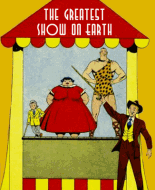Before bidding farewell to Brenda I wanted to address the question, "Why was there only one issue of
Brenda Starr?" The likeliest answer is that the sales figures didn't warrant another issue. Or perhaps the deal with the rights holder was only for one issue (less likely but I've heard of stranger things).
Whichever is the case, the question points to a bigger puzzle: why did the post-Western Dells tank?
As noted earlier, from 1938 to 1962 Dell comics were the product of a partnership between Dell Publishing, which financed and distributed the books, and Western Publishing, which produced them. At the head of the operation was Helen H. Meyer, a remarkable woman who started at Dell as a clerk in 1923 and rose to be president of the company (1950s-1976). Her influence went far beyond comics--she even signed Kurt Vonnegut and James Baldwin! Check out her Wikipedia bio:
https://en.wikipedia.org/wiki/Helen_Honig_MeyerAnyway, according to Wikipedia,
"Meyer spearheaded the licensing of Disney characters and directly selected material for publication." Apparently Western would present Meyer groups of potential projects (mostly licensed characters) and Meyer would decide which to publish. She obviously had good instincts. 1950s Dells sold millions of copies.
Meyer remained with Dell after Western split. One would imagine she, with all her experience, would have debuted a slick, cohesive lineup similar to the old Dell. Instead the new Dell seemed rather chaotic. Licensed titles were still prominent, though many of the properties were also-rans. (The loss of Disney,Tarzan, and the gang hurt badly.) Accompanying the licensed books were a raft of original titles, something Dell comics had mostly stayed away from. I love 'em, but you gotta wonder about some of the choices.
Tales from the Tomb?
Michael Shayne, set in the 1940s?
Some titles had respectable runs.
Ponytail had a dozen issues.
The Beverly Hillbillies racked up 18 and
Ghost Stories 20, and
Combat 26 before going to reprints. Most titles maxed out around 8-9 issues. In the beginning Dells looked pretty sharp on the newsstand, with painted covers and generally strong art. As the company went downhill both covers and interiors got sloppier. By the time the line folded in 1973 what books survived were in reprint.
Why didn't post-Western Dell catch on? I've seen speculation that launching the line with a 15 cent cover price--half again as much as other comics--was a big factor. I can see merit in that. Paying an extra nickel for brand new characters would have been a big deal for a 1961 kid. Another theory is that Dell didn't have a clear idea of their target audience. Some of the violence and weird concepts were far from the line's family-friendly beginnings. Another obstacle to Dells catching on might have been the company's insistence on quarterly publication. Three months is a long time in a kid's life. Having that much time between issues of a series like
Kona may have increased the likelihood a kid would lose interest.
Finally, there could have been behind-the-scenes factors I know nothing about. In a fascinating interview DJ Arneson refers to the first Dell editor, old-timer Len "LB" Cole, being canned after only a month on the job. I urge all Dell fans to read this interview, which appears along with one with Tony Tallarico. The main subject is the creation of the
Lobo western character, but there are lots of insights into the company.
https://jamiecoville.com/blog/blog/2016/08/17/lobo-creators-interview-dj-arneson-tony-tallarico/ Author
Topic: Reading Group #346 - Brenda Starr, Reporter - Female artist and iconic character (Read 720 times)
Author
Topic: Reading Group #346 - Brenda Starr, Reporter - Female artist and iconic character (Read 720 times)


